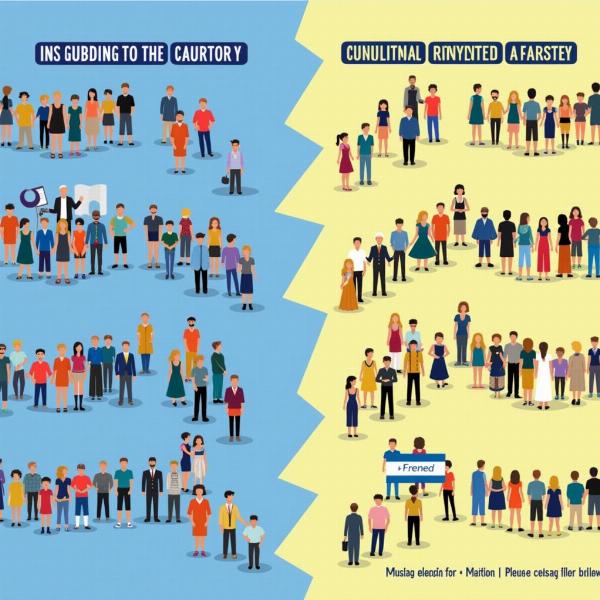Understanding the concept of a “communal electorate” is crucial for grasping the complexities of Indian electoral history and politics. This term, often translated as “साम्प्रदायिक निर्वाचन क्षेत्र” (sampradayik nirvachan kshetra) in Hindi, refers to a system where seats in legislative bodies are reserved for members of specific religious communities. This means that only members of a designated community can vote for candidates in that particular constituency. This practice has had a significant impact on the Indian political landscape, shaping representation and influencing inter-community relations.
What Does Communal Electorate Entail?
A communal electorate essentially creates separate electorates based on religious identity. This system, introduced during British rule, aimed to provide representation for minority communities. However, it also had the unintended consequence of potentially exacerbating communal divisions. In a communal electorate system, a Muslim candidate, for example, would primarily contest a seat reserved for Muslims and be voted for only by Muslim voters. This contrasted with a joint electorate, where all eligible voters, regardless of religion, could participate in the election. The idea behind communal electorates was to ensure that minority voices were not drowned out by the majority, guaranteeing their presence in legislative bodies.
The Historical Context of Communal Electorates in India
The introduction of communal electorates in India was a complex process, marked by political maneuvering and competing interests. The British, seeking to maintain control by exploiting existing societal divisions, introduced separate electorates through the Morley-Minto Reforms of 1909. This system further solidified religious identities in the political realm, contributing to the separate electorates for Muslims in subsequent reforms. The impact of this decision continued to be felt even after independence.
Criticisms and Consequences of Communal Electorates
While proponents argued that communal electorates protected minority interests, critics pointed to the divisive nature of such a system. By solidifying religious identities in politics, it arguably hindered the development of a unified national identity and fueled communal tensions. Critics contended that communal electorates fostered a sense of separatism rather than integration, further dividing society along religious lines.
 Impact of Communal Electorates
Impact of Communal Electorates
Communal Electorates vs. Joint Electorates
The debate between communal and joint electorates centered on the balance between minority representation and national unity. While communal electorates guaranteed representation for certain communities, joint electorates promoted a more inclusive and integrated political system. This was a key point of contention during the framing of the Indian constitution.
The Abolition of Communal Electorates in Independent India
After independence, India adopted a system of joint electorates, rejecting the divisive legacy of communal representation. This decision reflected the commitment to building a secular and unified nation. The Constitution of India guarantees equal voting rights to all citizens, irrespective of their religious affiliation.
Frequently Asked Questions (FAQs)
- What is the Hindi translation of “communal electorate”? It is often translated as “साम्प्रदायिक निर्वाचन क्षेत्र” (sampradayik nirvachan kshetra).
- Why were communal electorates introduced in India? They were introduced during British rule, ostensibly to provide representation for minority communities.
- What are the criticisms of communal electorates? Critics argue that they exacerbate communal divisions and hinder national unity.
- Does India currently have a system of communal electorates? No, India adopted joint electorates after independence.
- What is the difference between a communal electorate and a joint electorate? In a communal electorate, only members of a specific community can vote for candidates in that constituency. In a joint electorate, all eligible voters can participate regardless of their religious affiliation.
Conclusion
Understanding the meaning and implications of “communal electorate” is essential for comprehending India’s political history and the evolution of its electoral system. While the system aimed to address minority representation, its divisive consequences led to its eventual abolition in independent India. The shift towards joint electorates reflects the nation’s commitment to a secular and unified democracy.
Dr. Anita Sharma, Professor of Political Science at Jawaharlal Nehru University, states, “The abolition of communal electorates was a pivotal moment in Indian history, signifying a decisive move towards inclusivity and national integration.” Another expert, Mr. Rajesh Kumar, a constitutional lawyer, adds, “Joint electorates reinforce the principle of equality enshrined in the Indian constitution, ensuring that every citizen has an equal voice in the democratic process.”
Meaning-Hindi.in is your one-stop solution for all your Hindi translation needs. We specialize in various translation services, including Business and Commerce, Legal, Technical, Website Localization, Educational, and specialized translations. Our team of expert Hindi linguists and cultural experts ensures accuracy, cultural sensitivity, and high-quality translations. Contact us today for all your translation requirements. Email: [email protected], Phone: +91 11-4502-7584. Meaning-Hindi.in is committed to delivering accurate and culturally nuanced translations.